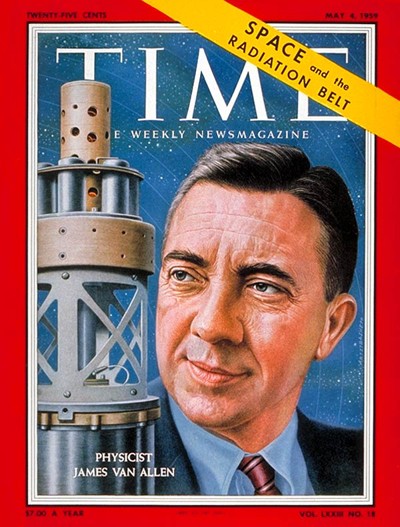
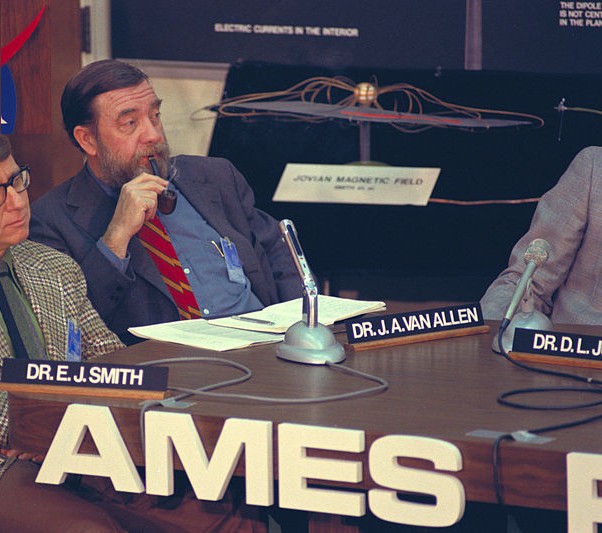

Professor Emeritus, Department of Physics and Astronomy, University of Iowa
Born in Mt. Pleasant, Iowa, graduate of Iowa Wesleyan University, and class valedictorian






Professor Emeritus, Department of Physics and Astronomy, University of Iowa
Born in Mt. Pleasant, Iowa, graduate of Iowa Wesleyan University, and class valedictorian



Van Allen didn't win his many awards for discovering a belt of harmless
radiation.
The radiation was so strong it stopped his Geiger counters
His experimental equipment was included on Explorer 1, 2 (blew up) and 3
His discovery saved the lives of astronauts who would have tried to go through the Belts.
|
|
||
|
|
Our measurements show that the maximum radiation level as of 1958 is equivalent to between 10 and 100 roentgens per hour, depending on the still-undetermined proportion of protons to electrons. Since a human being exposed for two days to even 10 roentgens would have only an even chance of survival, the radiation belts obviously present an obstacle to space flight. Unless some practical way can be found to shield space-travelers against the effects of the radiation, manned space rockets can best take off through the radiation-free zone over |
the poles. A "space station" must orbit below 400 miles or beyond
30,000 miles from the earth. We are now planning a satellite flight
that will test the efficacy of various methods of shielding. The hazard to space-travelers may not end even when they have passed the terrestrial radiation belts. According to present knowledge the other planets of our solar system may have magnetic fields comparable to the earth's and thus may possess radiation belts of their own. The moon, however, probably has no belt, because its magnetic field appears to be feeble. Lunar probes should give us more definite information on this point before long. |
Inner Belt 1000-8000 miles
Outer Belt 12000-25000 miles
Dr. Van Allen was under considerable pressure from the pro-moon landing scientists.
He was awarded, wined, dined, and persuaded by NASA to discount his own
experiments.
ntists get awarded for finding something beneficial, or dangerous - but not
harmless.
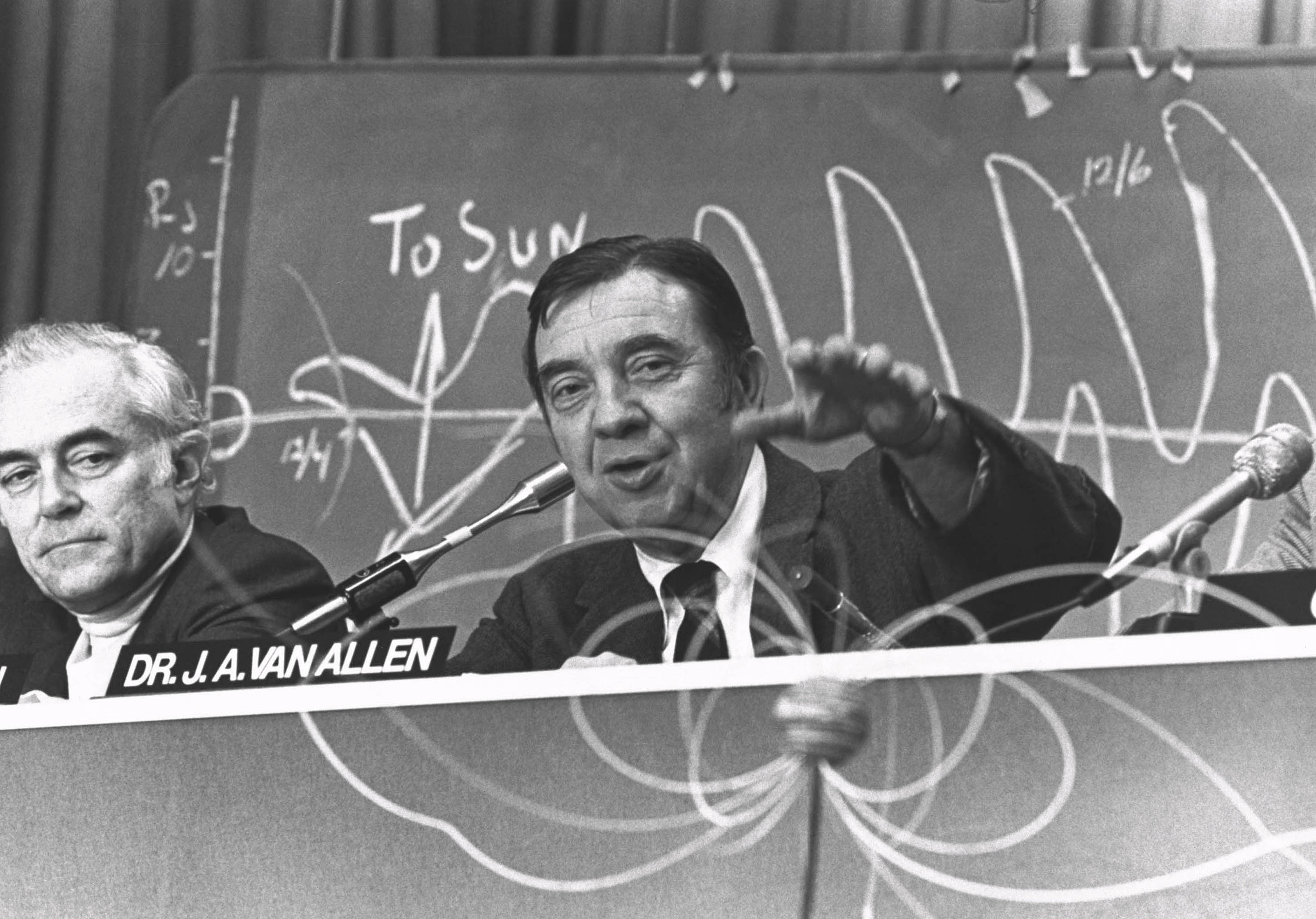


https://www.youtube.com/watch?v=q7pzg9xpAOE 22:30
James Van Allen was born in Mt. Pleasant, Iowa
and discovered the
Van Allen Belts of deadly radiation
that prevents man from going to the Moon
without strong protection such as lead shielding.
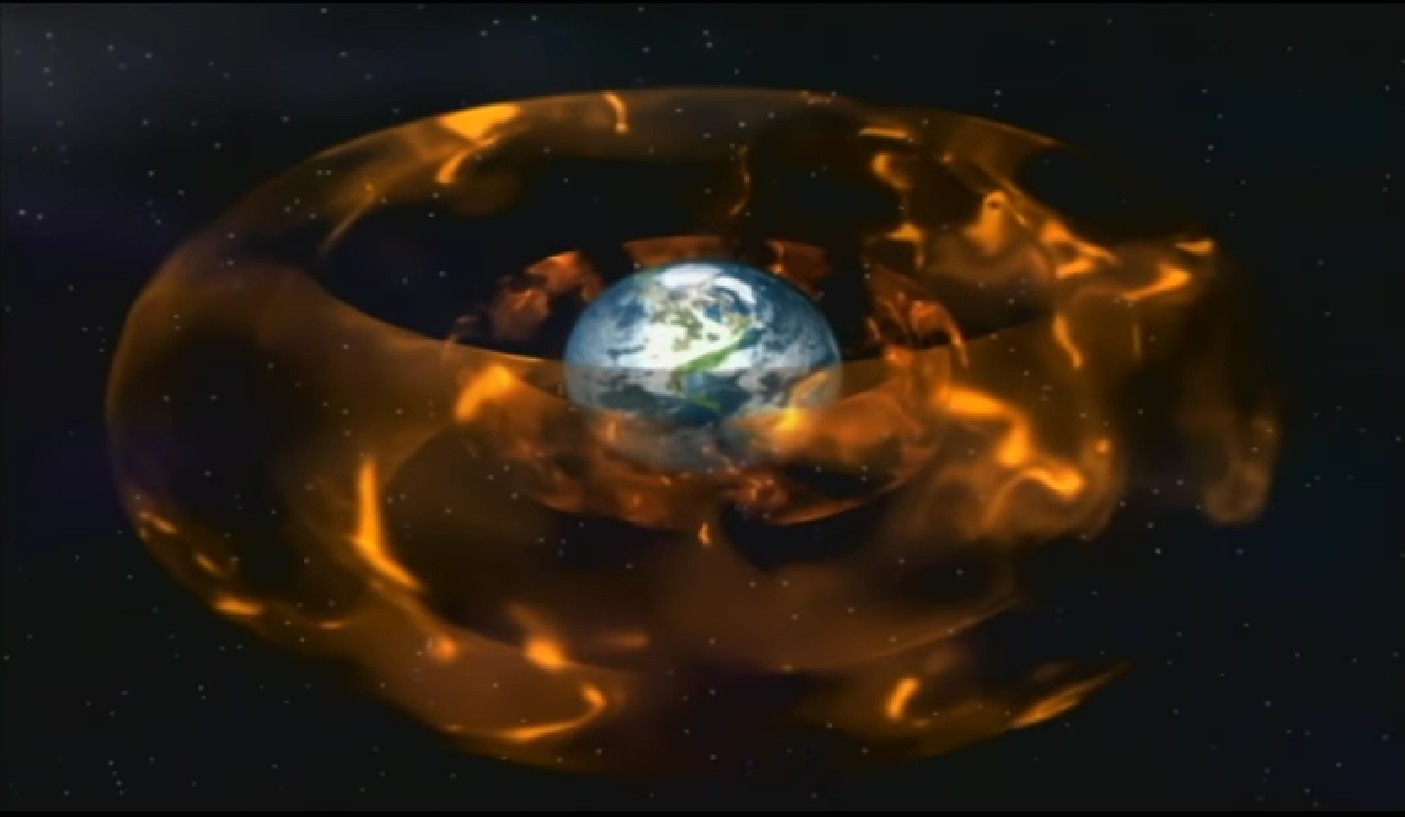
www.youtube.com/watch?v=xciCJfbTvE4#t=1974
But Dr. Van Allen said "this is nonsense"
in an email, possibly under duress or threats.
We don't know if the email was really from him, or the NSA intercepting emails.
He discovered a fatal radiation belt, then says it is nonsense?
Nonsense.
He never published any paper or article discounting his experiments or results.
The Van Allen Belt is a major obstacle to Moon landings.
He would have to speak against NASA and most Americans.
He would need very strong intestinal fortitude.
http://en.wikipedia.org/wiki/Van_Allen_radiation_belt
Note: currently someone supporting the official story posted on Wikipedia that
the Van Allen Belt is safe, but it also says:
The belts are a hazard for artificial satellites and are dangerous for human
beings, and are difficult and expensive to shield against.
Dr. James Van Allen did not get all the scientific awards for discovering a "harmless field of radiation". The VABelt is deadly, huge (60000 km / 37282 mi), and takes over 1.5 hours to get through at 39000 km/h or 24000 mph. He saved lives of astronauts who would have gone through it. Beyond the VAB astronauts get the full brunt of solar flares (at a high level 1969-1972). This is why the recent Orion rocket is unmanned, and measuring the radiation. Apollo astronauts could not withstand 100 REMs for hours when the IAEA occupational limit is 5 REMs per year.
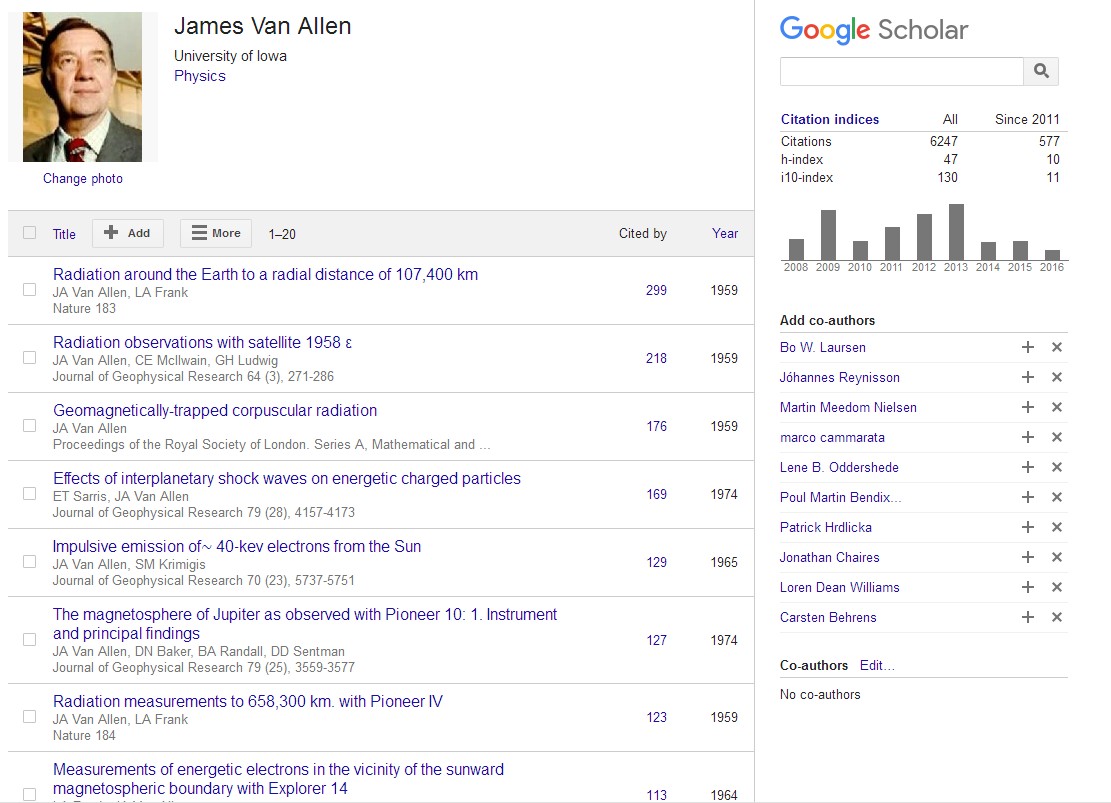
|
|
|
|
|
|
|
|
|
|
|
|
|
|
|
|
|
|
Alan Bean did not know beans about the Van Allen Belts
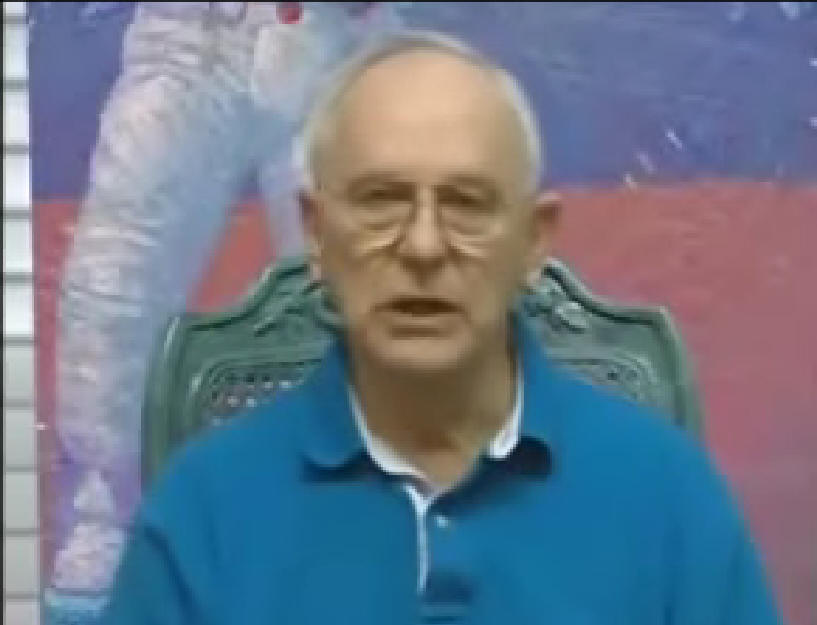
When confronted about the VAB, he hanges his story. Which story is the lie?
https://www.youtube.com/watch?v=-2FTZhyuJy8
Sickening Solar Flares

http://science.nasa.gov/science-news/science-at-nasa/2005/27jan_solarflares
|
The biggest solar proton storm in 15 years erupted last week. NASA researchers discuss what it might have done to someone on the Moon. January 27, 2005: NASA is returning to the Moon--not just robots, but people. In the decades ahead we can expect to see habitats, greenhouses and power stations up there. Astronauts will be out among the moondust and craters, exploring, prospecting, building. |
Note the first sentence: "NASA is returning to the Moon--not just
robots, but people."
This may be an admission that NASA never put people on the Moon, just remote
controlled robots.
|
|
|
http://www.epa.gov/radiation/understand/health_effects.html#anyamount
|
Exposure (rem) |
Health Effect |
Time to Onset (without treatment) |
|---|---|---|
| 5-10 | changes in blood chemistry | |
| 50 | nausea | hours |
| 55 | fatigue | |
| 70 | vomiting | |
| 75 | hair loss | 2-3 weeks |
| 90 | diarrhea | |
| 100 | hemorrhage | |
| 400 | possible death | within 2 months |
| 1,000 | destruction of intestinal lining | |
| internal bleeding | ||
| and death | 1-2 weeks | |
| 2,000 | damage to central nervous system | |
| loss of consciousness; | minutes | |
| and death | hours to days |
If you can "read between the lines" some NASA staff are trying to the truth.
NASA Orion mission Engineer Kelly Smith admits the Van
Allen Belts are dangerous

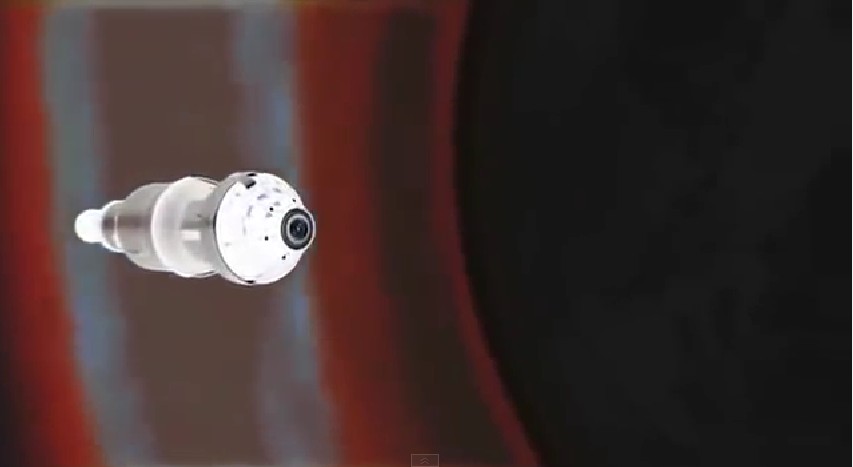

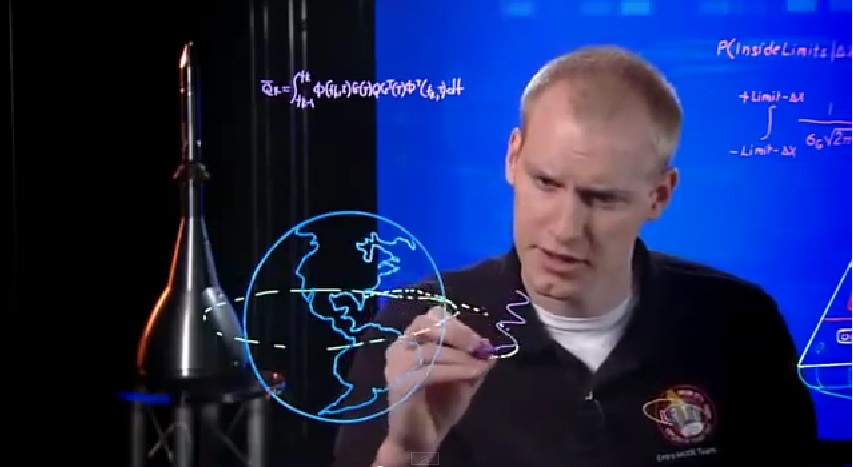
https://www.youtube.com/watch?v=IpXEpJAb8ZY
No astronauts will be aboard Orion, to measure the "extreme radiation"
"deeper into space than we have ever gone before"
"Van Allen Belts - an area of dangerous radiation"
"We must solve these challenges before we send people through this
region of space"
Wait a minute! Didn't NASA already do that in 1969?
NASA's Van Allen Radiation Belt Storm Probes (RBSP)
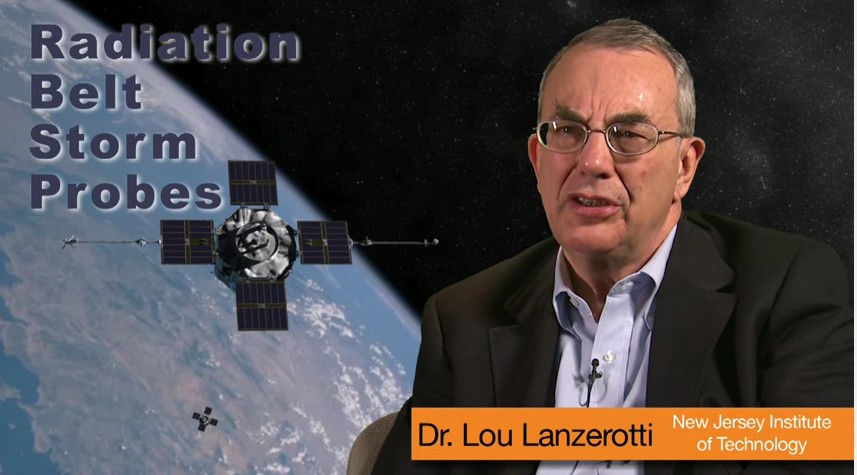

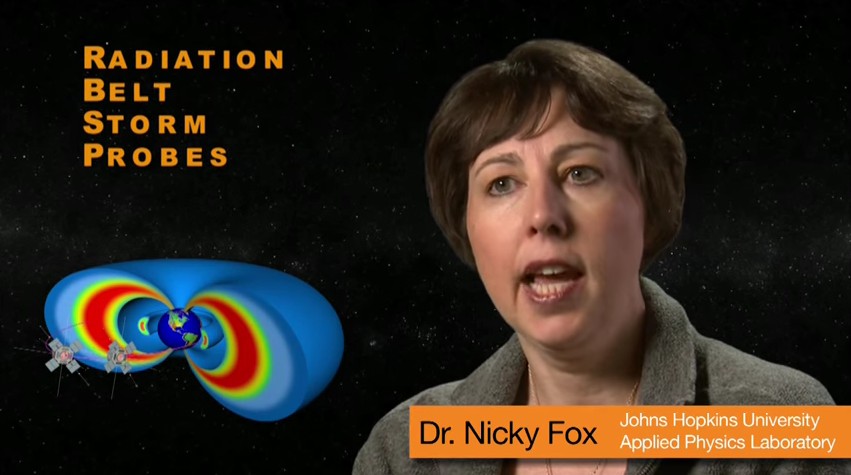

https://www.youtube.com/watch?v=3zNmgu6sQXk
Dr. Lou Lanzerotti - New Jersey Institute of Technology
Dr. Nicky Fox and Dr. Dan Smith - John Hopkins University, Applied Physics
Laboratory
Why an expensive probe of the Van Allen Belts if they were really "harmless"
to 1969-1972 Moon missions through them?
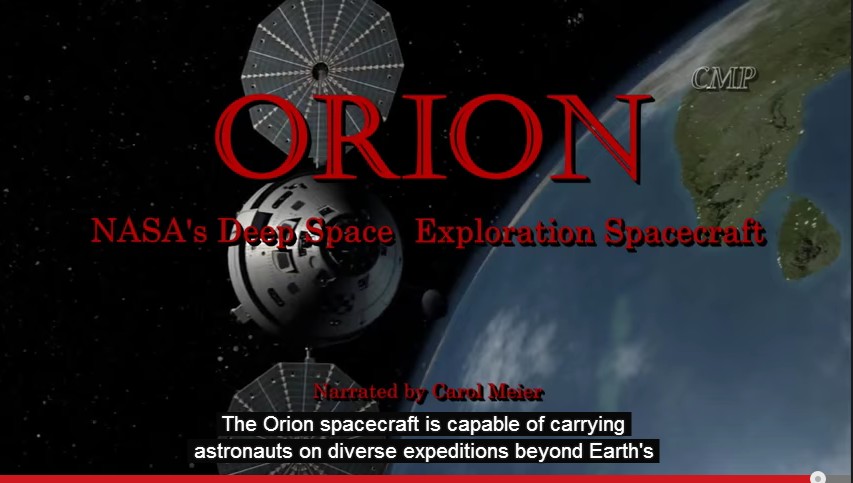

The problem of ensuring space flight safety arises from conditions inherent to space flights and outer space and from the existing weight limitations of spacecraft. In estimating radiation hazard during space flights, three natural sources are considered: the Earth's radiation belt, solar radiation, and galactic radiation.
| Vehicle Assembly Building | Van Allen Belt |
| Starts Apollo Moon missions | Stops it |
Possible Safe Route - Through the Poles of the Earth
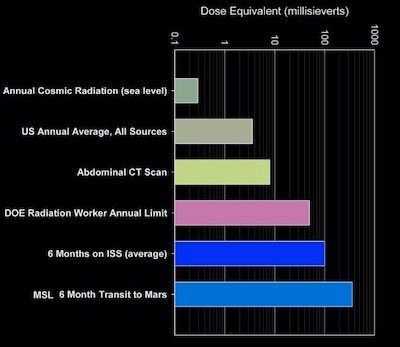
"The radiation environment in deep space is several hundred times more intense than it is on Earth, and that's even inside a shielded spacecraft, such as MSL, where we made our measurements," Zeitlin said.
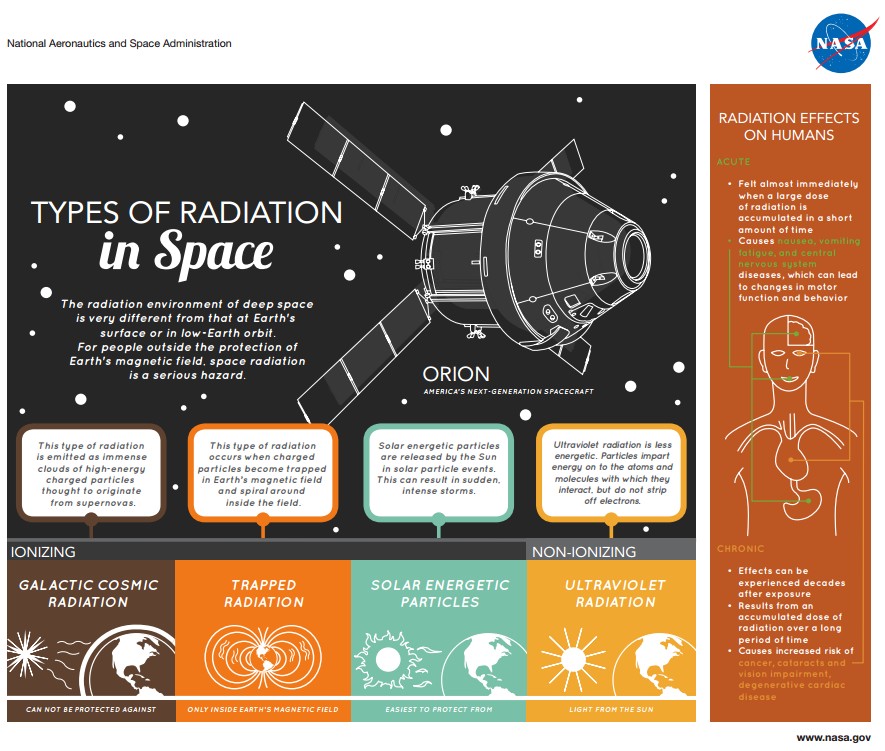
http://www.nasa.gov/sites/default/files/np-2014-03-001-jsc-orion_radiation_handout.pdf
Challenges of Spaceflight: Dealing with Space RadiationOrion, America’s next-generation spacecraft, will take astronauts to destinations beyond low-Earth orbit and thus outside the protective shield of Earth’s atmosphere and magnetic field. Without the protection Earth provides, the crew and systems of Orion will be exposed to the full spectrum of space radiation. To prepare for the effects of that exposure, scientists and engineers are working now to develop methods to protect them. THE DIFFERENCES BETWEEN RADIATION ON EARTH AND IN SPACERadiation on EarthOn Earth’s surface, we are protected from most of the radiation of the universe and the Sun by our atmosphere and magnetosphere. Non-ionizing RadiationNon-ionizing radiation refers to a less energetic – but still harmful – radiation in which particles impart energy on to the atoms and molecules with which it interacts, but does not strip off electrons. One form of non-ionizing radiation is ultraviolet, or UV, radiation, which you may be familiar with – we use sunscreen on Earth to shield ourselves from harmful UV rays. Radiation in SpaceIonizing RadiationThere are several forms of ionizing radiation in space. Ionizing radiation deposits energy onto the atoms and molecules with which it interacts, causing electrons to be lost. The resulting ions, or charged particles, give this form of radiation its name. One form of ionizing radiation is galactic cosmic radiation. This type of radiation is thought to come from supernovae, or exploding stars. While this radiation is low intensity, the particles associated with galactic cosmic radiation have a high level of energy and cannot be shielded with current spacecraft design technologies. |
The second form is trapped radiation, which occurs when radiation becomes trapped in Earth’s magnetic field. This type of radiation is not a problem outside of Earth’s magnetic field. Finally, solar energetic particles are released by the Sun in what are called solar particle events. This type of radiation is lower in energy, and is easier to protect astronauts and electronics from with shielding materials. EFFECTS OF SPACE RADIATION ON HUMANSSpace radiation can cause radiation sickness and other health problems. These effects are classified as either acute, which have immediate impacts on humans, or chronic, which affect humans over longer periods of time. Acute EffectsAcute effects can be felt almost immediately when a large dose of radiation is accumulated in a short amount of time. These effects can include acute radiation syndrome, which causes nausea, vomiting and fatigue. Chronic EffectsChronic effects are the results of an accumulated dose of radiation over longer periods of time. Chronic effects include an increased risk of cancer, for example. The onset of these diseases can happen decades after the exposure to radiation occurs. COUNTERMEASURESNASA protects astronauts from radiation in several ways during space flight. One that requires no special equipment is to limit the time humans spend exposed to radiation. For example, space walks are scheduled so that they do not occur during times of intense solar activity. Also, NASA limits the amount of radiation astronauts are exposed to during their careers. Every astronaut is required to wear a dosimeter during missions to keep track of the radiation to which they have been exposed. |
Spacecraft are built with materials that act as
shields against radiation. Some of the best materials available are those
that have a high concentration of hydrogen atoms, such as water. Most
spacecraft include a place with additional radiation shielding where the
astronauts can shelter in place during solar particle events.
ORION’S SPACE RADIATION PROTECTIONOrion is designed for both short missions to nearby destinations and long-distance missions to Mars that will last more than three years. As the average long-duration space flights for Americans have lasted about six months and have taken place entirely within low-Earth orbit, NASA must be prepared to deal with significantly more radiation than astronauts have experienced in the past. Orion will use the mass that is already on board to protect its crew by creating a temporary shelter in the aft bay of the spacecraft, which is the inside portion closest to the heat shield. This location minimizes the amount of equipment to move around while maximizing the amount of material that can be placed between the crew and the outside environment. The mass that will be used includes supplies, equipment and launch and re-entry seats, as well as water and food. By using the items already on board, the astronauts benefit from additional shielding without adding to Orion’s mass. Radiation Sensors Flying on Orion’s First MissionThe Orion spacecraft will have two types of radiation sensors on board during its first mission, Exploration Test Flight-1. The first type of sensor is called a Radiation Area Monitor, or RAM. There will be several of these sensors on board to record the peak level of radiation Orion is exposed to during the flight. The second type of radiation sensor being flown is the Battery-operated Independent Radiation Detector (BIRD). The BIRD sensor will be recording radiation levels throughout the mission for comparison to the mission telemetry after the completion of the flight. This will reveal where the radiation was encountered.
NP-2014-03-001-JSC |

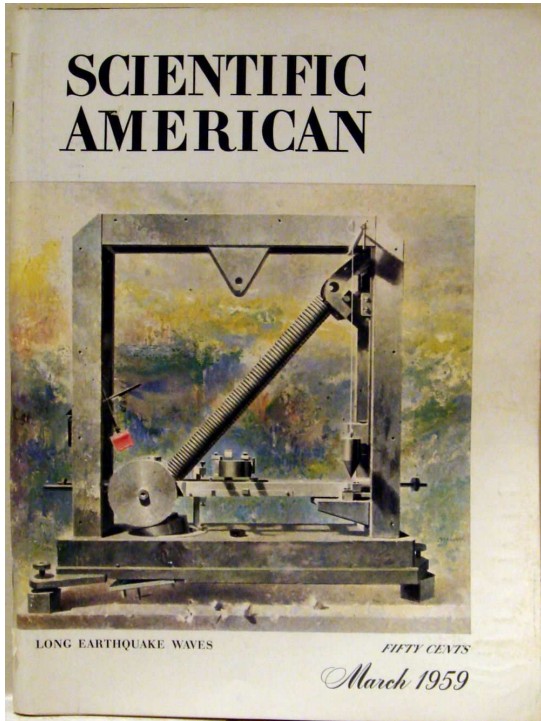



|
|
|
|
 |
Dr. Van Allen's letter to Jay Windley of
Clavius, and Lambert
in which he appears to take back the results of his years of scientific research
experiments
Jarrah White / MoonFaker: Radioactive Anomaly series
https://www.youtube.com/watch?v=9xlKooAbKpM
Lunarcy: NASA's Radiation Problem
www.youtube.com/watch?v=OKB5u_VTt6M
NASA's Orion capsule will be radiation resistant
https://www.nasa.gov/feature/scientists-and-engineers-evaluate-orion-radiation-protection-plan
Analysis of the Van Allen Belt Radiation
D.P. Wozney
www.ocli.com/~dpwozney/apollo5.htm
How to Protect Astronauts from Space Radiation on Mars
Dr. Corey Nislow, a cell biologist at the University of British Columbia:
"Such levels of radiation could lead to gruesome results. Neurons are some
of the first cells to get damaged. Blood vessels start to leak as micro bleeding
spreads throughout the circulatory system. As time goes by, the radiation starts
to damage your DNA, leading to blood cancers, tumours, and ultimately, death."
https://www.vancouverisawesome.com/highlights/bc-researcher-unveils-space-yeast-that-could-enable-deep-space-travel-6366253